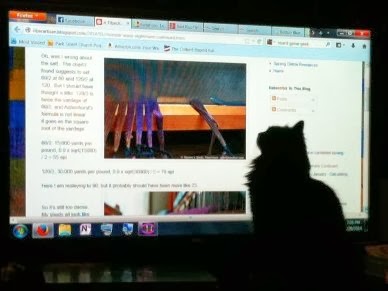 To wet-finish my towels, I just put them through a normal laundry cycle in the washer and dryer. Then I ironed them. To end at a good place in the weave pattern, I wove the towels a little short of the 38" recommended in the WJ article, about 37.5" under tension. Off the loom and before hemming, they measured about 36" x 17.5" - they lost a lot just coming off tension. After hemming, they were 32.5" long.
To wet-finish my towels, I just put them through a normal laundry cycle in the washer and dryer. Then I ironed them. To end at a good place in the weave pattern, I wove the towels a little short of the 38" recommended in the WJ article, about 37.5" under tension. Off the loom and before hemming, they measured about 36" x 17.5" - they lost a lot just coming off tension. After hemming, they were 32.5" long.Here's a photo before washing.

And here's the "after" photo. After washing, they measure 32" x 17" - not much shrinkage due to washing. The photo shows the spots closed up a little, but most of the movement of the yarns happened just by taking it off the loom.
You can see I had trouble keeping the motifs square and the diagonals at 45 degrees. I kept beating too hard. I found that I had to just barely squeeze the weft in place to keep it square.
I'm happy with my towels so far. Here's the plan for my three towels: the first I'm going to keep and use in my kitchen. The second I will send to a test kitchen among the households of my family members. The third one I will give to one of you, someone who wove January's towel along with me. Since only one weaver let me know (over on my Facebook page and google+) she was weaving along, the towel goes to her. Thanks for weaving along, Anna!
If you join in next month for February's towel and would like to win the Towel of the Month, please leave a comment to let us all know you're participating. You can put a link to photo(s) of your project, either finished or unfinished, in the comment. At the end of the month I'll draw names from a hat.

















